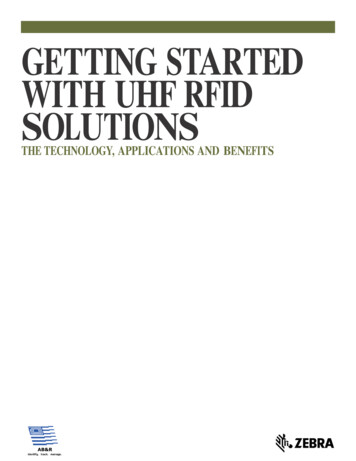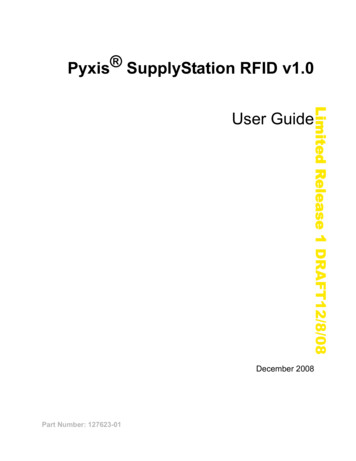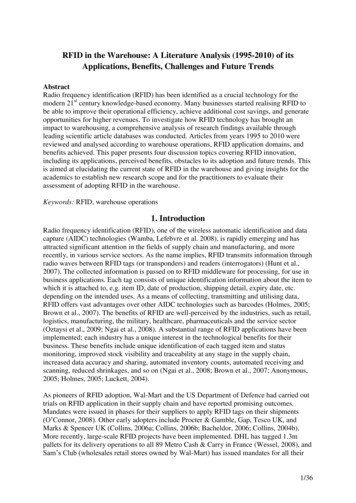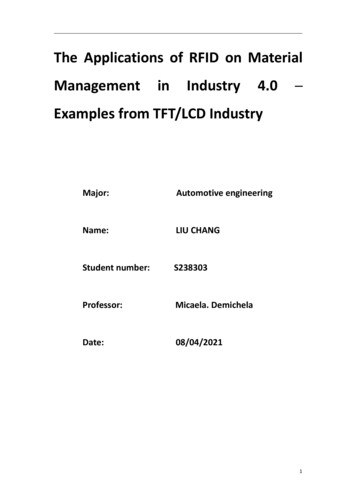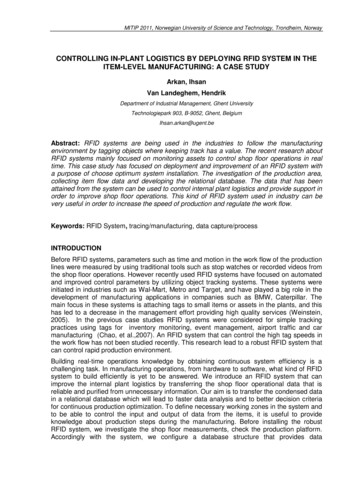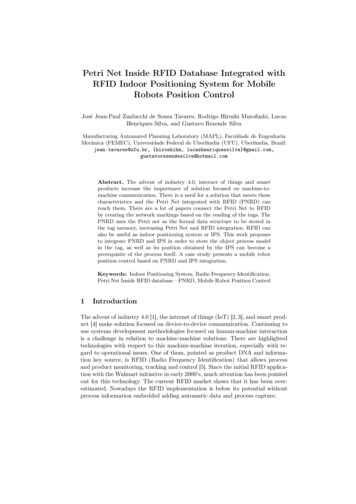
Transcription
Proceedings of the 2009 IEEE International Conference on Systems, Man, and CyberneticsSan Antonio, TX, USA - October 2009Distributed Intelligent RFID SystemsDilip B. KotakWilliam A. GruverSchool of Engineering ScienceSimon Fraser UniversityBurnaby, BC, Canadadilip.kotak@ieee.orgSchool of Engineering ScienceSimon Fraser UniversityBurnaby, BC, Canadagruver@cs.sfu.caAbstract—The major impetus for the use of RFID technologyis tracking personnel and objects to monitor and controlmovement. Traditionally, this task is accomplished using acentralized systems architecture in which every event istransmitted to a host computer for validation.Distributed intelligent systems are based on two principles:distributed communications and distributed intelligence.Together, these functionalities enable the implementation ofnetworks that are highly robust, scalable, flexible, and facilitatetheir integration with client/server systems.We describe how RFID can be implemented using distributedintelligent systems to automate data collection for service queues,track and control personnel and goods, monitor and controlinventory, and use dynamic digital signage for informationdissemination.Keywords—RFID, distributed intelligence, distributedcommunications, holonic systems, peer-to-peer networks,automated data collection, dynamic digital signage.I.INTRODUCTIONWidespread commercial adaptation of RFID hasaccelerated during the last decade because it is a significantimprovement on the functionality of bar-code technology andenables new possibilities. Advantages of RFID include: Non line-of-sight requirements, thus eliminating the needfor alignment of tags and readers; Automating tag reading without human intervention; Ability to write information on tags.Because RFID readers do not require line-of-sight, it ispossible to place antennas and readers in locations that aremore secure and inconspicuous, thereby enabling applicationsthat are not possible or difficult to implement with bar-codetechnology.RFID systems monitor, track, and control the movement ofobjects and personnel to ensure that authorized objects andpersonnel are in authorized zones at authorized times. Withincreased security concerns worldwide, expanding movementof goods and people, and more complex logistics, the need formonitoring, tracking, and control have become a critical factor.However, when an unauthorized object or person appears inan unauthorized zone at an unauthorized time, unless anappropriate action is taken, simple detection is insufficient.RFID systems are usually integrated with a client/serverarchitecture in which intelligence resides on centralized serversand databases. In such systems, the RFID reader mustcommunicate with a server and wait for a response before anaction can be taken. If delays or bottlenecks occur in thenetwork, the response is delayed. When the server or networkis unavailable, the system ceases to function. Therefore, theability of an RFID system to provide an appropriate responsedepends on the ability of the centralized system to providecommunications and validation.RFID systems can be implemented with distributedintelligence to enable local decision making near the readers.This approach provides faster response to events whileminimizing network traffic and dependence upon centralizedservers, thereby improving the response, reliability, andavailability of the network.This paper describes how holonic intelligence, a specialcase of distributed intelligent system technologies, can beimplemented to automate data collection for service queues,track and control personnel and goods, monitor and controlinventory, and use dynamic digital signage for informationdissemination.II.Centralized networks are built on client/server networkarchitectures in which information and decision making rulesand policies are stored on servers and are passed from client toclient via servers.This approach can be viewed as centralizedcommunications with centralized intelligence. However, it hastwo major weaknesses: Lack of robustness because the entire network depends onthe availability of the server to provide communications aswell as access to information and intelligence. Whencommunications to the server or the server itself iscompromised, the entire network ceases to function; Lack of scalability because the network must bereconfigured when new nodes are added. Since additionalnodes may increase communications, network bandwidthmay become a bottleneck.Distributed intelligent systems are based on twocharacteristics that distinguish them from centralizedclient/server systems: distributed communications anddistributed intelligence.978-1-4244-2794-9/09/ 25.00 2009 IEEE978-1-4244-2794-9/09/ 25.00 2009 IEEEDISTRIBUTED INTELLIGENT SYSTEMS1245
Unlike centralized systems, where each node communicateswith other nodes via a server, each node in a distributedcommunications network is capable of communicating withnodes that are within its communication range. If a node needsto communicate with a node that is out of communicationsrange, it may be possible to do so by multi-hopping. Dependingon the density of the network, a source node may be able toaccess the destination node using alternate paths.This feature of distributed communications networks hasthe following advantages: Improved scalability because new nodes can be added tothe network, thus increasing its density within a givenrange or extending the range of the network; Improved robustness because alternative routing paths areavailable for moving information from a source node to adestination node, thus mitigating potential failures andbottlenecks; Throughput performance improves with the density of thenetwork, contrary to centralized systems; Integration with centralized systems is facilitated becauseany node on a distributed communications network can bedirectly connected to a centralized communication system.A useful method for providing distributed decision makingat each node of a network is Holonic Intelligence, acollaborative agent technology that was introduced by ArthurKoestler in The Ghost in the Machine [1] and developed by theHolonic Manufacturing Systems Consortium, amajorinternational research program of the Intelligent ManufacturingSystems Program [2]. Negotiation techniques such as bilateral auctions andcontract net protocols are used to enable coordination ofagents; Holonic Intelligence Systems have system level objectivesthat are achieved through coordinated decisions madelocally at individual nodes. This permits each node toadapt to specific requirements while fulfilling systemobjectives.Holonic Intelligence Systems have the advantages ofrobustness, scalability, and they facilitate integration withclient/server systems [6,7,8].A. Holonic Intelligence PlatformTo develop a distributed intelligent system, we use anintegrated wireless hardware and software platform tocoordinate nodes within the network [9]. The HolonicIntelligence Platform consists of the following hardwarecomponents and software as described in Fig. 1: A computer processor andoperating system to locallyexecuteHolonicsystemssoftware; On-board memory for localstorage of data and otherinformation; A wireless transceiver utilizingindustry standard protocols forpeer-to-peercommunicationsbetween nodes; Holonic systems software toenableintelligentroutingbetween nodes, locally store andprocessinformation,andprovide local decision support inresponse to detected events.Holonicsystemssoftwareenables neighboring nodes tocooperateandcoordinatedecisions affecting more thanone node. It also provides thecapability to exchange information without having to accesscentralized servers, but havingfull access to servers whennecessary [10,11,12,13].The functionality of a Holonic Intelligence System isanalogous to that of an ant colony. Whereas a single ant has alimited level of intelligence for following a pheromonedeposited by another ant, finding a shorter path, and leaving apheromone for other ants to follow, an ant colony has a highercapability emerging from the collective intelligence ofindividual ants that communicate and cooperate in order toadapt to changing circumstances. Thus, the intelligence of thecolony as a whole emerges from basic interactions betweenants and the simple intelligence replicated in each ant. Similarphenomena can be observed in team sports where playerscommunicating and collaborating can be more effective thanindividual star players.Key aspects of holonic systems are as follows [3,4,5]:Figure 1. Holonic Intelligence Platform They involve both hardware and software; They utilize collaborative agent technologies for the software component; Soft computing techniques such as fuzzy logic, geneticalgorithms, and multi-criteria optimization can beemployed to implement local intelligence;The Holonic Intelligence Node consists of a HolonicIntelligence Platform with RFID readers and other sensors asinputs, and audio/video and actuators as outputs (Fig. 2). Withon-board processing, memory, and peer-to-peer communications, a Holonic Intelligence Node provides functionality forlocal communications and control that can be customized for abroad range of applications.1246
B. Holonic Intelligence NodeRFID TagRFID AntennaHolonic IntelligencePlatformDigital SignageRFID ReaderProcessorRFID TagMemoryAlarmSensorsWireless TransceiverFigure 3. Holonic Intelligence NetworkHolonic IntelligenceEntry LockHolonic Intelligence Platforms can be wirelessly connectedin a network as shown in Fig. 3. One or more of these nodesalso be connected to a server to collect, process, anddisseminate data for billing and other corporate needs.Figure 2. Holonic Intelligence NodeC. Holonic Intelligence TowerThe Holonic Intelligence Tower is a portable, selfcontained unit that can be rapidly deployed to create a wirelesspeer-to-peer network with RFID readers, digital displays, andother input/output devices for specific applications. Since thetransceiver in the Holonic Intelligence Platform utilizesindustry-standard communication protocols, a network ofHolonic Intelligence Towers can be connected to a centralizedsystem to exchange and process data. The Holonic IntelligenceTower includes the following components:Biometric Module for fingerprint and facerecognition;Audiovisual Module with digital displays todeliver high-resolution images, full motion videowith audio, or simple character displays;Data Entry Module with a digital tablet,keyboard/trackball, or touch screen for data entry;RFID Module with an RFID reader andantennas for active or passive tags withappropriate transmission frequencies (LF, HF, orUHF) for the application;Holonic Intelligence Platform consisting of amicroprocessor,flashmemory,wirelesstransceiver, and Holonic systems software;Power Module for powering all componentsby 120/240 VAC or a rechargeable battery.III.DISTRIBUTED INTELLIGENT RFID SYSTEMSA. Tracking and Control of Personnel and GoodsTraditionally, RFID tracking of personnel and goods isaccomplished with a centralized systems architecture in whichevery event is transmitted to a host computer for validation. Ifthe connection to the server fails the system ceases to functionbecause there is no local intelligence available to makedecisions.Access control technologies use electronic cards that arevalidated through a centralized database and connected to cardreaders. If the connection to the centralized database fails, thesystem cannot function because it lacks information to continuethe validation process.Bar coding is one of the most popular technologies fortracking assets. However, bar coding also depends upon accessto centralized database servers to validate and recordtransactions. Although handheld bar code scanners may locallystore information, validation cannot occur until the scanners areconnected to database servers.Because a Holonic Intelligence Network avoids the need toaccess centralized databases for each transaction it is morerobust compared to a centralized architecture. Centralizeddatabases can integrate all transactions occurring at individualcheck points by the wireline or wireless communicationscapability built into the Holonic Intelligence Platform.The Holonic Intelligence Platform enables connectivity toinput devices such as bar code scanners, RFID readers,audio/video devices, CCTV systems, biometric readers, andoutput devices such as audio/video devices, alarms, and lockingmechanisms.Holonic Intelligence provides a means to implement ascalable system in which nodes can be quickly added at checkpoints without having to install fixed wiring and reconfigurethe system. This solution is more robust because it does notrequire access to a centralized database for each transaction.Because the Holonic Intelligence Platform provides localprocessing and data storage, and has standardized input/output1247
ports (serial, USB, VGA), devices can be connected toimplement personnel, asset tracking, and access control.B. Inventory Tracking and ControlInventory management is a specialized case of asset orproduct tracking. It is key to successful warehousing,distribution, and manufacturing operations. Traditionally, barcode technology has been used for inventory management,however, many companies are now incorporating RFID.Most of these systems rely on centralized database serversand client/server communication to establish communicationsbetween bar code scanners and RFID readers, . Typically, theinfrastructure used for such systems is based on fixed wiringand is therefore difficult to reconfigure to meet the changingrequirements of business.The Holonic Intelligence Platform provides the ability toflexibly deploy inventory tracking with wireless and wirelineconnectivity, distributed networks, and enable local transactionprocessing and control.By providing local intelligence at each reader location,faster and more secure response is obtained without the need toaccess a centralized database for each event. This approach isnot intended to replace legacy client/server systems, but ratherto extend and enhance their functionality.C. Dynamic Digital SignageTraditional advertising sends generic information to itsaudience regardless of the context. Digital signage has made itpossible to change the information being sent depending uponthe time and place, however, most current systems employcentralized servers to send preprogrammed advertising.Dynamic digital signage systems convey advertising orproduct/service information that is specific to customer needs.Frequently, merchandise is tethered by a cable that activates aswitch to display information for the product selected by thecustomer. Non-contact systems activated by RFID tags are alsobeing utilized.The difficulty with such approaches is that they usetraditional client/server architectures with centralized databaseservers to distribute information. This approach requires thatthe communication system and centralized servers are alwaysavailable and that communication bandwidth and processingpower are sufficient to accommodate the customer activatedrequests.The Holonic Intelligence Platform is specifically designedfor high bandwidth applications such as video. It has amicroprocessor and memory to locally store and processinformation at each node, thus significantly reducingdependence on the communication network and availability ofthe server.Applications of the Holonic Intelligence Platform areautomated data collection at airports, shopping malls, retailstores, distribution warehouses, supply chains, manufacturingand service industry such as banking, hospitals, and thehospitality industry.D. Automated Data Collection for Service QueuesManaging service queues is one of the most important tasksfor ensuring quality customer service. Queue length andwaiting time are key parameters to measure the effectiveness ofservice. Traditionally, these statistics are gathered manually. Inthe majority of cases, however, queues are managed by trialand error. Service organizations attempt to balance the cost ofproviding service versus customer satisfaction. Changes inprocedures for airport security screening, for example, can havea great impact on controlling queue length and waiting times,and, therefore, the ability of the airport to manage passengerflow.Currently, airports employ manual surveys for short periodsof one week or less to samplepassenger flow through thesecurity screening stations forthe purpose of estimatingpersonnel requirements.Fig. 4 illustrates howautomated data collection canbe implemented for securityscreening. A system ofHolonic Intelligence Towerscontaining RFID readers arelocated at the followingpoints:Figure 4. Airport Passenger Screening At the entry point of the queue; Where passengers place carry-on luggage on the conveyerfor x-ray scanning and before proceeding through themetal detectors; Where passengers collect carry-on luggage and leave thesecurity screening area.By this configuration, data related to queue service time,delays, and queue lengths can be collected for subsequentanalysis. In addition, digital signage also can display passengerwaiting times based on data being collected.Furthermore, if passenger carry-on luggage, laptops andpersonal items are tagged at the check-in station, data can becollected to ensure that passengers are entering appropriatesecurity areas and are carrying items that belong to them.In a similar manner, surveys can be conducted at banks,grocery stores, fast food restaurants, and other places where theanalysis of service queues and service times is important.IV.FUTURE OPPORTUNITIES AND CONCLUSIONSThe adoption of RFID technologies is increasing asorganizations discover their benefits and the costs ofimplementation decrease. RFID systems need to cover largerand more difficult to reach areas and be more adaptable to meetthe operating demands of new applications. These systemshave to respond quickly and be available 24/7. DistributedRFID systems have the potential to provide increasedscalability, adaptability, and robustness, and provide decisionmaking at the point where tags are interrogated.1248
Using the analogy of an ant colony, individual ants haveonly a limited level of intelligence, and yet the colony has amuch higher level of intelligence that allows it to survive.[8]M. Fleetwood, D. B. Kotak, S. Wu, and H. Tamoto, “Holonic systemarchitecture for scalable infrastructures,” Proc. of the 2003 IEEEInternational Conference on Systems, Man, and Cybernetics,Washington, DC USA, 2003.In the past, intelligent systems research has often focusedon incorporating levels of complexity. However, theintelligence residing in centralized servers does not allow forcooperation and coordination between individual nodes.Methods are needed to distribute the simplest level ofintelligence in individual agents. Coordination algorithms areneeded to enable a higher level of intelligence to emerge in theoverall system.[9]S. Ovcharenko, Z. Alibhai, C. Ng, W. A. Gruver, and D. Sabaz,“Implementation of a wireless distributed intelligent system,” Proc. ofthe 2006 IEEE International Workshop on Intelligent DistributedSystems, Prague, Czech Republic, June 2006.The challenge is to develop effective methods fordetermining the form of simple intelligence that can be builtinto individual agents and determine the interactions that arerequired between them so that the desired degree of emergingintelligence is achieved. A corollary is to ensure thatundesirable systems behavior does not emerge, and, if it does,to detect and mitigate such behaviors. Understanding ofbiological systems in nature provides excellent opportunitiesfor future research [14,15].[11] D. Sabaz, Z. Alibhai, C. Ng, and W. A. Gruver, “Multi-agent frameworkfor distributed trading,” Proc. of the 2006 IEEE International Workshopon Intelligent Distributed Systems, Prague, Czech Republic, June 2006.As described in Section III of this paper, the use ofdistributed communications combined with distributedintelligence creates new opportunities for RFID systems thatare difficult to implement with traditional client/serverarchitectures. Issues to be addressed include interoperability,selection of operating and communications protocols,integration with hardware and software, and genericapplications software that can be quickly customized forspecific customers.[10] C. Ng, Z. Alibhai, D. Sabaz, O. Uncu, and W. A. Gruver, “Frameworkfor developing distributed systems in a peer-to-peer environment,” Proc.of the 2006 IEEE International Conference on Systems, Man, andCybernetics, Taipei, Taiwan, October 2006.[12] C. Ng, D. Sabaz, and W. A. Gruver, “VNET: A distributed algorithmsimulator for wireless peer-to-peer networks,” Proc. of the 2004 IEEEInternational Conference on Systems, Man, and Cybernetics, TheHague, Netherlands, October 2004.[13] E. Chen, D. Sabaz, and W. A. Gruver, “JADE and JXTA Extensions forthe implementation of distributed systems,” Proc. of the 2006 IEEEInternational Conference on Systems, Man, and Cybernetics, Taipei,Taiwan, October 2006.[14] A. Tharumarajah, A. J. Wells, and L Nemes, “Comparison of bionic,fractal and holonic manufacturing system concepts,” InternationalJournal of Computer Integrated Manufacturing, 1996.[15] A. Tharumarajah, “A self-organising view of manufacturingenterprises,” Computers in Industry, Vol. 51, Issue 2, June 2003.REFERENCES[1]A. Koestler, The Ghost in the Machine, Arkana Books, 1967.[2]W. A. Gruver, D. B. Kotak, E. H. van Leeuwen, and D. Norrie, “HolonicManufacturing Systems - Phase 2,” Proc. of the InternationalConference on Industrial Applications of Holonic and Multi-AgentSystems (HoloMAS 2003), Prague, Czech Republic, September 2003.[3]R. W. Brennan, J. H. Christensen, W. A. Gruver, D. B. Kotak, D. H.Norrie, and E. van Leeuwen, “Holonic Manufacturing Systems – ATechnical Overview,” Industrial Information Technology Handbook,CRC Press, 2004.[4]V. Marik and M. Pechoucek, “Holons and agents: Recent developmentsand mutual impacts,” Proc. of the Twelfth International Workshop onDatabase and Expert Systems Applications, IEEE Computer Society,2001.[5]D. C. McFarlane and S. Bussman, “Holonic manufacturing control:rationales, developments and open issues,” M. Deen (ed.) Agent-BasedManufacturing: Advances in the Holonic Approach, 2003.[6]D. Sabaz, W. A. Gruver, and M. H. Smith, “Distributed systems withagents and holons,” Proc. of the 2004 IEEE International Conference onSystems, Man, and Cybernetics, The Hague, Netherlands, October 2004.[7]D. Sabaz and W.A. Gruver, “Distributed intelligent systems: Whatmakes them intelligent,” Proc. of the IEEE Symposium on Microwave,Antenna, Propagation and EMC Technologies for WirelessCommunications, Beijing, China, 2005.1249
Holonic Manufacturing Systems Consortium, a major international research program of the Intelligent Manufacturing Systems Program [2]. The functionality of a Holonic Intelligence System is analogous to that of an ant colony. Whereas a single ant has a limited level of intelligence for following a pheromone


